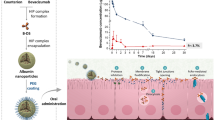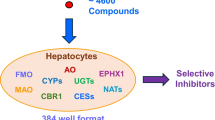Abstract
Purpose. The purpose of the study was to evaluate several n-in-one cocktails of heterogeneous compounds to increase the throughput of permeability studies across Caco-2 monolayers, to investigate the reliability and applicability of the method, and to develop fast and sensitive analysis for the compounds. Compounds with potential interactions in efflux and/or active transport were chosen.
Methods Permeability experiments with verapamil, propranolol, midazolam, hydroxyzine, timolol, buspirone, procaine, naproxen, ketoprofen, and antipyrine as single compounds and in cocktails of 5-10 compounds were performed at 50 μM concentration both in the apical-to-basolateral and basolateral-to-apical direction. The compounds were quantified by liquid chromatography-electrospray tandem mass spectrometry (LC-ESI/MS/MS). Toxicity tests were performed to determine cellular damage.
Results The analytical method was sensitive, accurate, and rapid. The individual permeabilities of compounds in cocktails correlated well with permeabilities as single compounds. No significant interactions between the compounds within the mixtures were observed, except for acidic compounds. The studied mixtures did not show any toxicity.
Conclusions The use of n-in-one cocktails is a suitable method to improve the capacity in routine permeability experiments and higher throughput screening of drug candidates, although potential interactions should always be borne in mind. The use of LC-ESI/MS/MS technology provides an excellent tool in fast and accurate analysis of small amounts of heterogeneous compounds.
Similar content being viewed by others
REFERENCES
M. Markowska, R. Oberle, S. Juzwin, C.-P. Hsu, M. Gryszkiewicz, and A. J. Streeter. Optimizing Caco-2 cell monolayers to increase throughput in drug intestinal absorption analysis. J. Pharmacol. Toxicol. Methods 46:51-55 (2001).
C. Tannergren, P. Langguth, and K.-J. Hoffmann. Compound mixtures in Caco-2 cell permeability screens as a means to increase screening capacity. Pharmazie 56:337-342 (2001).
Z. Wang, C. Hop, K. Leung, and J. Pang. Determination of in vitro permeability of drug candidates through a Caco-2 cell monolayer by liquid chromatography/ tandem mass spectrometry. J. Mass Spectrom. 35:71-76 (2000).
H.-Z. Bu, M. Poglod, R. Micetich, and J. Khan. High-throughput Caco-2 cell permeability screening by cassette dosing and sample pooling approaches using direct injection/on-line guard cartridge extraction/tandem mass spectrometry. Rapid Commun. Mass Spectrom. 14:523-528 (2000).
C. Bailey, P. Bryla, and W. Malick. The use of intestinal epithelial cell culture model, Caco-2, in pharmaceutical development. Adv. Drug Deliv. Rev. 22:85-103 (1996).
K. Palm, K. Luthman, J. Ros, J. Gråsjö, and P. Artursson. Effect of molecular charge on intestinal epithelial drug transport: pH-dependent transport of cationic drugs. J. Pharmacol. Exp. Ther. 291:435-443 (1999).
T. Ogihara, I. Tamau, H. Takanaga, Y. Sau, and A. Tsuji. Stereoselective and carrier-mediated transport of monocarboxylic acids across Caco-2 cells. Pharm. Res. 13:1828-1832 (1996).
S. Yamashita, T. Furubayashi, M. Kataoka, T. Sakane, H. Sezaki, and H. Tokuda. Optimized conditions for prediction of intestinal drug permeability using Caco-2 cells. Eur. J. Pharm. Sci. 10:195-204 (2000).
H. Takanaga, I. Tamau, and A. Tsuji. pH-dependent and carrier-mediated transport of salicylic-acid across Caco-2 cells. J. Pharm. Pharmacol. 46:567-570 (1994).
A. Shapiro and V. Ling. Positively cooperative sites for drug transport by P-glycoprotein with distinct drug specificities. Eur. J. Biochem. 250:130-137 (1997).
C. Pascaud, M. Garrigos, and S. Orlowski. Multidrug resistance transporter P-glycoprotein has distinct but interacting binding sites for cytotoxic and reversing agents. Biochem. J. 333:351-358 (1998).
E. Wang, C. Casciano, R. Clement, and W. Johnson. Two transport binding sites of P-glycoprotein are unequal yet contingent: initial rate kinetic analysis by ATP hydrolysis demonstrates intersite dependence. Biochim. Biophys. Acta 1481:63-74 (2000).
S. Orlowski, L. Mir, J. Belehradek, and M. Garrigos. Effects of steroids and verapamil on P-glycoprotein ATPase activity: progesterone, desoxycorticosterone, corticosterone and verapamil are mutually non-exclusive modulators. Biochem. J. 317:515-522 (1996).
T. Tsuruo, H. Iida, S. Tsukagoshi, and Y. Sakurau. Overcoming of vincristine resistance in P388 leukemia in vivo and in vitro through enhanced cytotoxicity of vincristine and vinblastine by verapamil. Cancer Res. 41:1967-1972 (1981).
J. Hunter, B. H. Hirst, and N. L. Simmons. Drug absorption limited by P-glycoprotein-mediated secretory drug transport in human intestinal epithelial Caco-2 cell layers. Pharm. Res. 10:743-749 (1993).
P. Anderle, E. Niederer, W. Rubas, C. Hilgendorf, H. Spahn-Langguth, H. Wunderli-Allenspach, H. Merkle, and P. Langguth. P-glycoprotein (P-gp) mediated efflux in Caco-2 cell monolayers: the influence of culturing conditions and exposure on P-gp expression levels. J. Pharm. Sci. 87:757-762 (1998).
J. Polli, S. Wring, J. Humphreys, L. Huang, J. Morgan, L. Webster, and C. Serabjit-Singh. Rational use of in vitro P-glycoprotein assays in drug discovery. J. Pharmacol. Exp. Ther. 299:620-628 (2001).
T. Mosmann. Rapid colorimetric assay for cellular growth and survival: application to proliferation and cytotoxicity assays. J. Immunol. Methods 65:55-63 (1983).
L. Gyürösiová, L. Laitinen, J. Raiman, J. Cižmárik, and E. Sedlárová. and J. Hirvonen. Permeability profiles of malkoxysubstituted pyrrolidinoethylesters of phenylcarbamic acid across Caco-2 monolayers and human skin. Pharm. Res. 19:162-168 (2002).
T. Decker and M. L. Lohmann-Matthes. A quick and simple method for the quantitation of lactate dehydrogenase release in measurements of cellular cytotoxicity and tumor necrosis factor (TNF) activity. J. Immunol. Meth. 115:61-69 (1988).
W. M. Kan, Y. T. Liu, C. L. Hsiao, S. Y. Shieh, J. H. Kuo, J. D. Huang, and S. F. Su. Effect of hydroxyzine on the transport of etoposide in rat small intestine. Anticancer Drugs 12:267-273 (2001).
T. Terao, E. Hisanaga, Y. Sau, I. Tamau, and A. Tsuji. Active secretion of drugs from the small intestinal epithelium in rats by P-glycoprotein functioning as an absorption barrier. J. Pharm. Pharmacol. 48:1083-1089 (1996).
M. F. Paine, D. D. Shen, K. L. Kunze, J. D. Perkins, C. L. Marsh, J. P. McVicar, D. M. Barr, B. S. Gillies, and K. E. Thummel. First-pass metabolism of midazolam by the human intestine. Clin. Pharmacol. Ther. 60:14-24 (1996).
R. Kirn, C. Wandel, B. Leake, M. Cvetkovic, M. Fromm, P. Dempsey, M. Roden, F. Belas, A. Chaudhary, D. Roden, A. Wood, and G. Wilkinson. Interrelationship between substrates and inhibitors of human CYP3A and P-glycoprotein. Pharm. Res. 16:408-413 (1999).
J. Hunter and B. H. Hirst. Intestinal secretion of drugs. The role of P-glycoprotein and related drug efflux systems in limiting oral drug absorption. Adv. Drug Deliv. Rev. 25:129-157 (1997).
J. Yang, K.-J. Kim, and V. H. L. Lee. Role of P-glycoprotein in restricting propanolol transport in cultured rabbit conjunctival epithelial cell layers. Pharm. Res. 17:533-538 (2000).
S. Doppenschmitt, H. Spahn-Langguth, C. G. Regådh, and P. Langguth. Role of P-glycoprotein-mediated secretion in absorptive drug permeability: an approach using passive membrane permeability and affinity to P-glycoprotein. J. Pharm. Sci. 88:1067-1072 (1999).
J. Gao, O. Murase, R. Schowen, J. Aube, and R. T. Borchardt. A functional assay for quantitation of the apparent affinities of ligands of P-glycoprotein in Caco-2 cells. Pharm. Res. 18:171-176 (2001).
J. Karlsson, S.-M. Kuo, J. Ziemniak, and P. Artursson. Transport of celiprolol across human intestinal epithelial (Caco-2) cells: mediation of secretion by multiple transporters including P-glycoprotein. Br. J. Pharmacol. 110:1009-1016 (1993).
A. Tsuji, H. Takanaga, I. Tamau, and T. Terasaki. Transcellular transport of benzoic acid across Caco-2 cells by a pH-dependent and carrier-mediated transport mechanism. Pharm. Res. 11:30-37 (1994).
Author information
Authors and Affiliations
Rights and permissions
About this article
Cite this article
Laitinen, L., Kangas, H., Kaukonen, A.M. et al. N-in-One Permeability Studies of Heterogeneous Sets of Compounds Across Caco-2 Cell Monolayers. Pharm Res 20, 187–197 (2003). https://doi.org/10.1023/A:1022262818573
Issue Date:
DOI: https://doi.org/10.1023/A:1022262818573




